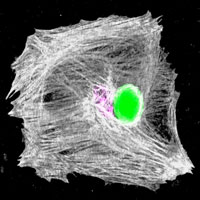 It sounds like science fiction - but lasers beating to the rhythm of a live heart is exactly what researchers have developed to improve the understanding of heart failure and to help develop more effective treatments.
It sounds like science fiction - but lasers beating to the rhythm of a live heart is exactly what researchers have developed to improve the understanding of heart failure and to help develop more effective treatments.
Tuesday, June 30, 2020
Feel the beat: implanted microlasers scan heart from inside
 It sounds like science fiction - but lasers beating to the rhythm of a live heart is exactly what researchers have developed to improve the understanding of heart failure and to help develop more effective treatments.
It sounds like science fiction - but lasers beating to the rhythm of a live heart is exactly what researchers have developed to improve the understanding of heart failure and to help develop more effective treatments.
Biocompatible, piezoelectric nanofibers can help repair broken bones
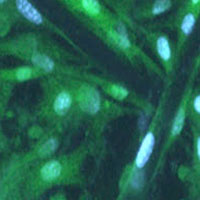 Healing broken bones could get easier with a device that provides both a scaffold for the bone to grow on and electrical stimulation to urge it forward.
Healing broken bones could get easier with a device that provides both a scaffold for the bone to grow on and electrical stimulation to urge it forward.
Researchers find contactless way to measure thickness of carbon nanotube films
 Scientists have figured out a non-invasive way to measure the thickness of single-walled carbon nanotube films, which may find applications in a wide variety of fields from solar energy to smart textiles.
Scientists have figured out a non-invasive way to measure the thickness of single-walled carbon nanotube films, which may find applications in a wide variety of fields from solar energy to smart textiles.
Wide graphene nanoribbon promises the next generation of miniaturized electronics
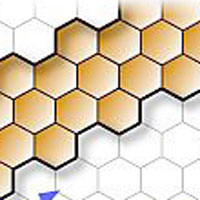 A research group introduced the widest graphene nanoribbon prepared by the bottom-up approach with electrical properties surpassing those of silicon semiconductors, promising a new generation of miniaturized electronic devices.
A research group introduced the widest graphene nanoribbon prepared by the bottom-up approach with electrical properties surpassing those of silicon semiconductors, promising a new generation of miniaturized electronic devices.
Mary, Mary, quite contrary, how does your crystal grow?
 Researchers have managed to create structures that are a complete paradox: single, continuous crystals that have multiple domains, an asymmetric shape and curved lines; they are as complex as one could expect from a 'monumental' structure.
Researchers have managed to create structures that are a complete paradox: single, continuous crystals that have multiple domains, an asymmetric shape and curved lines; they are as complex as one could expect from a 'monumental' structure.
Light from inside the tunnel
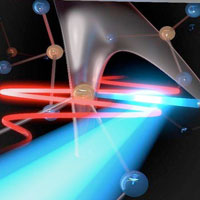 Physicists have revealed a so-far overlooked nonlinear optical mechanism that emerges from the light-induced tunneling of electrons inside dielectrics.
Physicists have revealed a so-far overlooked nonlinear optical mechanism that emerges from the light-induced tunneling of electrons inside dielectrics.
How to design more reliable nano- and micro-electro-mechanical systems
 Scientists present insights from sophisticated small-scale mechanical experiments explaining unexpected plastic deformation of silicon on the nanoscale.
Scientists present insights from sophisticated small-scale mechanical experiments explaining unexpected plastic deformation of silicon on the nanoscale.
Nanocoatings could reduce complications after implant surgery
 Researchers have developed a new method of applying anti-inflammatory substances to implants in order to inhibit undesirable inflammatory reactions in the body.
Researchers have developed a new method of applying anti-inflammatory substances to implants in order to inhibit undesirable inflammatory reactions in the body.
Monday, June 29, 2020
Cartwheeling light reveals new optical phenomenon
 Scientists have discovered details about a novel type of polarized light-matter interaction with light that literally turns end over end as it propagates from a source. Their find could help study molecules like those in light-harvesting antennas anticipated to have unique sensitivity to the phenomenon.
Scientists have discovered details about a novel type of polarized light-matter interaction with light that literally turns end over end as it propagates from a source. Their find could help study molecules like those in light-harvesting antennas anticipated to have unique sensitivity to the phenomenon.
Researchers catch a wave to determine how forces control granular material properties
 Physicists used X-ray measurements and analyses to show that velocity scaling and dispersion in wave transmission is based on grainy particle arrangements and chains of force between them, while reduction of wave intensity is caused mainly from grainy particle arrangements alone.
Physicists used X-ray measurements and analyses to show that velocity scaling and dispersion in wave transmission is based on grainy particle arrangements and chains of force between them, while reduction of wave intensity is caused mainly from grainy particle arrangements alone.
Multifunctional nanofiber protects against explosions
 Researchers have developed a lightweight, multifunctional nanofiber material that can protect wearers from both extreme temperatures and ballistic threats.
Researchers have developed a lightweight, multifunctional nanofiber material that can protect wearers from both extreme temperatures and ballistic threats.
Producing a gaseous messenger molecule inside the body, on demand
 Method could shed light on nitric oxide's role in the neural, circulatory, and immune systems.
Method could shed light on nitric oxide's role in the neural, circulatory, and immune systems.
Engineers use 'DNA origami' to identify vaccine design rules
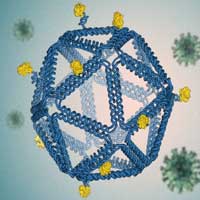 In lab tests, virus-like DNA structures coated with viral proteins provoke a strong immune response in human B cells.
In lab tests, virus-like DNA structures coated with viral proteins provoke a strong immune response in human B cells.
The first liquid retina prosthesis
 Liquid, biocompatible and micro-injectable, the new retinal prosthesis is an aqueous suspension of photoactive nanoparticles that functionally replace the photoreceptors of the retina damaged by degenerative diseases and aging.
Liquid, biocompatible and micro-injectable, the new retinal prosthesis is an aqueous suspension of photoactive nanoparticles that functionally replace the photoreceptors of the retina damaged by degenerative diseases and aging.
Physicists see surprisingly strong light, high heat from nanogaps between plasmonic electrodes
 Seeing light emerge from a nanoscale experiment didn't come as a big surprise to physicists. But it got their attention when that light was 10,000 times brighter than they expected.
Seeing light emerge from a nanoscale experiment didn't come as a big surprise to physicists. But it got their attention when that light was 10,000 times brighter than they expected.
Researchers control elusive spin fluctuations in 2D magnets
 Researchers developed a new imaging technique that is fast and sensitive enough to observe these elusive critical fluctuations in two-dimensional magnets. This real-time imaging allows researchers to control the fluctuations and switch magnetism via a 'passive' mechanism that could eventually lead to more energy-efficient magnetic storage devices.
Researchers developed a new imaging technique that is fast and sensitive enough to observe these elusive critical fluctuations in two-dimensional magnets. This real-time imaging allows researchers to control the fluctuations and switch magnetism via a 'passive' mechanism that could eventually lead to more energy-efficient magnetic storage devices.
A new theory for semiconductors made of nanocrystals
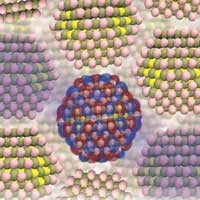 Scientists have provided the first theoretical explanation for how electrical current is conducted in semiconductors made of nanocrystals. In the future, this could lead to the development of new sensors, lasers or LEDs for TV screens.
Scientists have provided the first theoretical explanation for how electrical current is conducted in semiconductors made of nanocrystals. In the future, this could lead to the development of new sensors, lasers or LEDs for TV screens.
Stopping the unstoppable with atomic bricks
 A research team developed method for trapping elusive electrons.
A research team developed method for trapping elusive electrons.
Researchers print, tune graphene sensors to monitor food freshness, safety
 Researchers are using high-resolution printing technology and the unique properties of graphene to make low-cost biosensors to monitor food safety and livestock health.
Researchers are using high-resolution printing technology and the unique properties of graphene to make low-cost biosensors to monitor food safety and livestock health.
Friday, June 26, 2020
'Simulation microscope' examines transistors of the future
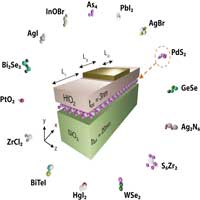 Using a supercomputer, researchers have simulated and evaluated one hundred possible materials for designing high-performance transistors and discovered 13 promising candidates.
Using a supercomputer, researchers have simulated and evaluated one hundred possible materials for designing high-performance transistors and discovered 13 promising candidates.
Chemistry paves the way for improved electronic materials
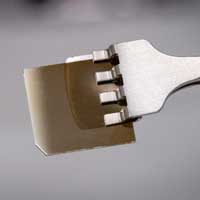 Indium nitride is a promising material for use in electronics, but difficult to manufacture. Scientists have developed a new molecule that can be used to create high-quality indium nitride, making it possible to use it in, for example, high-frequency electronics.
Indium nitride is a promising material for use in electronics, but difficult to manufacture. Scientists have developed a new molecule that can be used to create high-quality indium nitride, making it possible to use it in, for example, high-frequency electronics.
Cellulose nanocrystals for manufacturing advanced materials
 A review of the scientific literature highlights the potential of hybrid materials based on cellulose nanocrystals.
A review of the scientific literature highlights the potential of hybrid materials based on cellulose nanocrystals.
Developing new techniques to improve atomic force microscopy
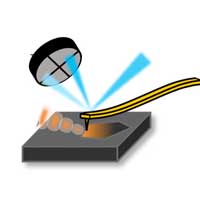 Researchers have developed a new method to improve the noise associated with nanoscale chemical imaging using atomic force microscopy. The improvements will increase the versatility and the precision of the instrument.
Researchers have developed a new method to improve the noise associated with nanoscale chemical imaging using atomic force microscopy. The improvements will increase the versatility and the precision of the instrument.
Spin-gapless semiconductors review
 Spin-gapless semiconductors with their fascinating spin and charge states hold great potential for future spintronic technology.
Spin-gapless semiconductors with their fascinating spin and charge states hold great potential for future spintronic technology.
Thursday, June 25, 2020
Scientists unveil mechanism to obtain metal 'nanoscrews'
 Researchers deposit gold atoms onto gold nanorods in a practically helicoidal structure.
Researchers deposit gold atoms onto gold nanorods in a practically helicoidal structure.
Chemists achieve breakthrough in the synthesis of graphene nanoribbons
 Researchers have succeeded in producing graphene nanoribbons for the first time directly on the surface of semiconductors. Until now, this was only possible on metal surfaces.
Researchers have succeeded in producing graphene nanoribbons for the first time directly on the surface of semiconductors. Until now, this was only possible on metal surfaces.
Researchers discover new boron-lanthanide nanostructure
 A newly discovered nanocluster has a geometry that has not been observed in chemistry heretofore.
A newly discovered nanocluster has a geometry that has not been observed in chemistry heretofore.
New 'hybrid engine' for biodegradable nanomotors that transport drugs to diseased tissue
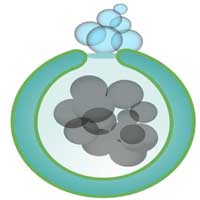 Inorganic nanoparticles stored in the nanomotors create oxygen nanobubbles for propulsion.
Inorganic nanoparticles stored in the nanomotors create oxygen nanobubbles for propulsion.
Simple process for 'two-faced' nanomaterials may aid energy, information tech
 Researchers used a simple process to implant atoms precisely into the top layers of ultra-thin crystals, yielding two-sided structures with different chemical compositions. The resulting materials, known as Janus structures after the two-faced Roman god, may prove useful in developing energy and information technologies.
Researchers used a simple process to implant atoms precisely into the top layers of ultra-thin crystals, yielding two-sided structures with different chemical compositions. The resulting materials, known as Janus structures after the two-faced Roman god, may prove useful in developing energy and information technologies.
Intense light pulses bounce on a crystalline bed without rumpling the atomic blanket
 Scientists developed a new technique that uses intense X-ray pulses to measure how atoms move in a sheet of material just one molecule thick.
Scientists developed a new technique that uses intense X-ray pulses to measure how atoms move in a sheet of material just one molecule thick.
Scientists find out how nanoparticles kill cancer cells
 Scientists have studied how magnet nanoparticles affect cancer cells in the human liver.
Scientists have studied how magnet nanoparticles affect cancer cells in the human liver.
Dynamics of DNA replication revealed at the nanoscale
 New study using super resolution technology gives new insight into a poorly understood area of DNA replication.
New study using super resolution technology gives new insight into a poorly understood area of DNA replication.
Wavy surfaces for better light control
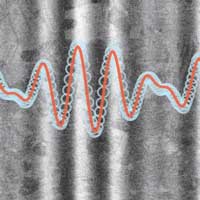 Researchers have developed a method for the production of wavy surfaces with nanometre precision. In the future this method could be used, for instance, to make optical components for data transmission on the internet even more efficient and compact.
Researchers have developed a method for the production of wavy surfaces with nanometre precision. In the future this method could be used, for instance, to make optical components for data transmission on the internet even more efficient and compact.
Researchers realize atomic resolution imaging at 30.1 T in hybrid magnet
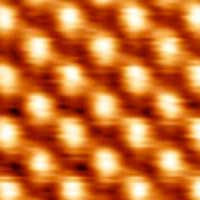 Researchers have constructed the world's first atomically resolved scanning tunneling microscope (STM) in a hybrid magnet to obtain atomic resolved STM images of graphite in an ultra-high 30.1 T magnetic field and bore of 32mm diameter setting the highest magnetic field for the hybrid magnet,and the same time marking a new magnetic field record for any atomic resolution measurement.
Researchers have constructed the world's first atomically resolved scanning tunneling microscope (STM) in a hybrid magnet to obtain atomic resolved STM images of graphite in an ultra-high 30.1 T magnetic field and bore of 32mm diameter setting the highest magnetic field for the hybrid magnet,and the same time marking a new magnetic field record for any atomic resolution measurement.
Physicists obtain molecular 'fingerprints' using plasmons
 Researchers have proposed a new way to study the properties of individual organic molecules and nanolayers of molecules. The approach relies on V-shaped graphene-metal film structures.
Researchers have proposed a new way to study the properties of individual organic molecules and nanolayers of molecules. The approach relies on V-shaped graphene-metal film structures.
Measure squeezing in a novel way
 Scientists have developed a completely new method of measuring 'squeezing' - a potential starting point for high-precision sensor technology.
Scientists have developed a completely new method of measuring 'squeezing' - a potential starting point for high-precision sensor technology.
Gold nanoparticles to save neurons from cell death
 A new study opens important perspectives for treatment of diseases such as Alzheimer's and Huntington's disease, but also epilepsy, brain trauma and stroke.
A new study opens important perspectives for treatment of diseases such as Alzheimer's and Huntington's disease, but also epilepsy, brain trauma and stroke.
Trapping the sun: New thin-film technology uses sustainable components for solar panels
 Environment-friendly solar panels consisting of the abundant materials Cu, Zn, Sn are hindered by their low practical efficiency compared to their theoretical potential. Researchers have now discovered a way to overcome these hurdles.
Environment-friendly solar panels consisting of the abundant materials Cu, Zn, Sn are hindered by their low practical efficiency compared to their theoretical potential. Researchers have now discovered a way to overcome these hurdles.
New insights into the energy levels in quantum dots
 With their experiments, scientists confirmed certain energy transitions in quantum dots that had previously only been predicted theoretically: the so-called radiative Auger process.
With their experiments, scientists confirmed certain energy transitions in quantum dots that had previously only been predicted theoretically: the so-called radiative Auger process.
Comb on a chip: New design for 'optical ruler' could revolutionize clocks, telescopes, telecommunications
 Just as a meter stick with hundreds of tick marks can be used to measure distances with great precision, a device known as a laser frequency comb, with its hundreds of evenly spaced, sharply defined frequencies, can be used to measure the colors of light waves with great precision.
Just as a meter stick with hundreds of tick marks can be used to measure distances with great precision, a device known as a laser frequency comb, with its hundreds of evenly spaced, sharply defined frequencies, can be used to measure the colors of light waves with great precision.
Ultrathin boron nitride films for next-generation electronics
 A novel material could enable major leaps in the miniaturization of electronic devices.
A novel material could enable major leaps in the miniaturization of electronic devices.
Self-powered alarm fights forest fires, monitors environment
 Scientists designed and fabricated a remote forest fire detection and alarm system powered by nothing but the movement of the trees in the wind.
Scientists designed and fabricated a remote forest fire detection and alarm system powered by nothing but the movement of the trees in the wind.
Tuesday, June 23, 2020
Researchers cut nanometer-sized patterns into 2D materials
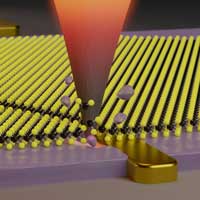 Researchers have developed a high-precision technology that enables them to carve nanometric patterns into two-dimensional materials.
Researchers have developed a high-precision technology that enables them to carve nanometric patterns into two-dimensional materials.
Microscopic computers: The wires of the future may be made of molecules
 There are physical limits to how powerful computers can become if they are to maintain their size. Molecular electronics can solve that problem, and now researchers are contributing to this field with a new, efficient conducting material, based on molecules.
There are physical limits to how powerful computers can become if they are to maintain their size. Molecular electronics can solve that problem, and now researchers are contributing to this field with a new, efficient conducting material, based on molecules.
Using chaos as a tool, scientists discover new method of making 3D-heterostructured materials
 Scientists have developed a new approach for generating layered, difficult-to-combine, heterostructured solids.
Scientists have developed a new approach for generating layered, difficult-to-combine, heterostructured solids.
New quantum materials with unique properties
 A new EU project focuses on quantum materials, whose properties can be modified significantly by elastic deformation.
A new EU project focuses on quantum materials, whose properties can be modified significantly by elastic deformation.
Manipulating tiny skyrmions with small electric currents
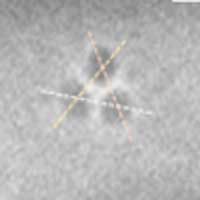 Researchers have managed to manipulate and track the movement of individual magnetic vortices called skyrmions, which have been touted as strong candidates to act as information carriers in next-generation storage devices and as synapses for neuromorphic computing.
Researchers have managed to manipulate and track the movement of individual magnetic vortices called skyrmions, which have been touted as strong candidates to act as information carriers in next-generation storage devices and as synapses for neuromorphic computing.
Twisted WSe2 as a highly tunable platform for the study of exotic phenomena
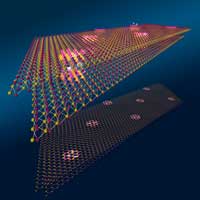 Researchers report that the twisted bilayer transition metal dichalcogenide WSe2 enables the realization of exotic correlated phenomena, including high-Tc superconductivity and correlated insulators, in a controlled manner and without the geometrical restriction found in twisted bilayer graphene.
Researchers report that the twisted bilayer transition metal dichalcogenide WSe2 enables the realization of exotic correlated phenomena, including high-Tc superconductivity and correlated insulators, in a controlled manner and without the geometrical restriction found in twisted bilayer graphene.
A structural light switch for magnetism
 Scientists have managed to drive a prototypical antiferromagnet into a new magnetic state using terahertz frequency light.
Scientists have managed to drive a prototypical antiferromagnet into a new magnetic state using terahertz frequency light.
'Unboil an egg' machine creates improved bacteria detector
 Traditional fluorescent dyes to examine bacteria viability are toxic and suffer poor photostability - but using the Vortex Fluidic Device has enabled the preparation of a new generation of aggregation-induced emission dye luminogens using graphene oxide.
Traditional fluorescent dyes to examine bacteria viability are toxic and suffer poor photostability - but using the Vortex Fluidic Device has enabled the preparation of a new generation of aggregation-induced emission dye luminogens using graphene oxide.
Subscribe to:
Posts (Atom)
